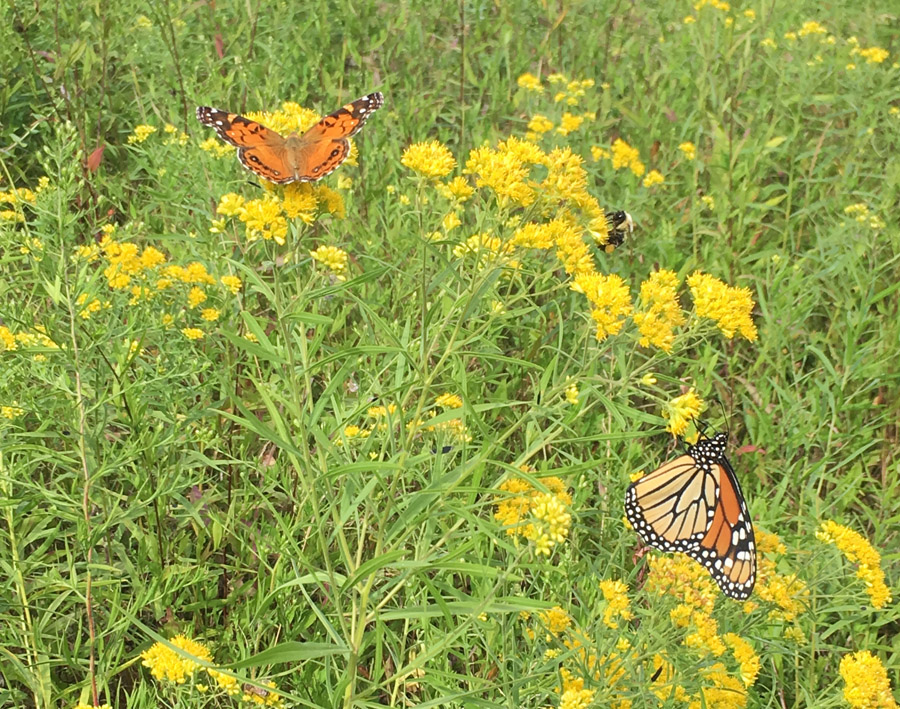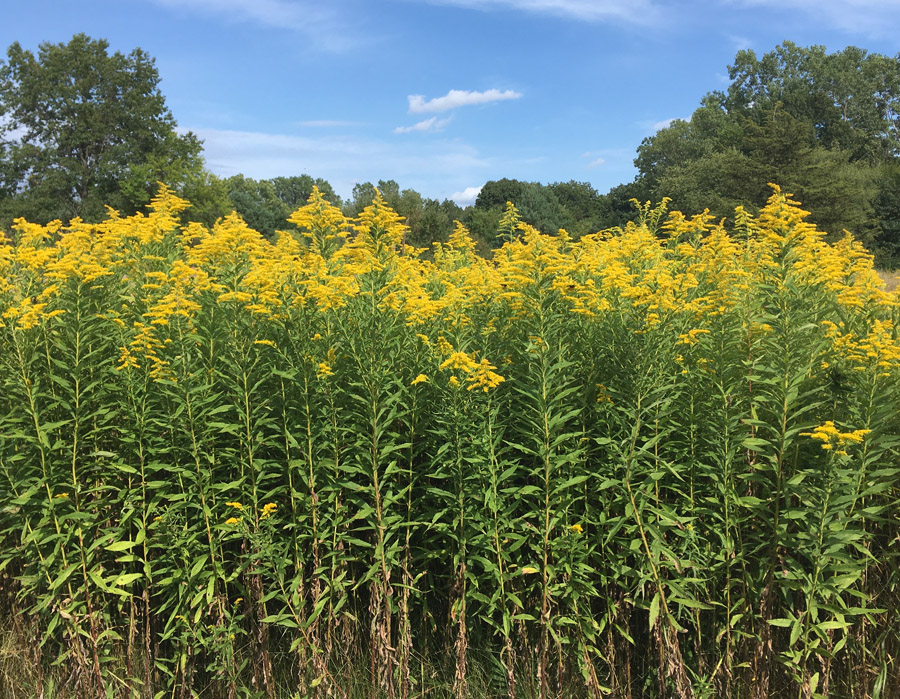“Why so many asters and goldenrods now? The sun has shone on the earth, and the goldenrod is his fruit. The stars, too, have shone on it, and the asters are their fruit.”
– Thoreau, the Journal, August 30, 1853.
The common goldenrods, known scientifically as Solidago spp., are indeed an apt metaphor for the winding-down of a long summer. These showy and abundant members of the Aster family spend the transitional month of September turning many a roadside and meadow into a tide of sunny yellow, as they once again plan the biggest party of the year — to which every hungry pollinator is invited.

Solidago is a genus of more than a hundred closely related species, nearly all of which bloom in late summer. Native to various parts of North America, it is regularly encountered in the locally appropriate form in many parts of the country, where it is an important late-season food for the local cast of beneficial, nectar-seeking insects.
Thus it was probably not the Solidago canadensis pictured above, but a near relative, that once interrupted a stroll with a companion of mine in Seattle, Washington many years ago. As we passed a large clump that I had already passed a hundred times — mildly resenting its crowding of the curb, as it exuberantly billowed out from a tiny crack in the sidewalk — she suddenly stopped in her tracks and, in a remarkably more constructive reaction than my own, proceeded to gather a large bouquet to take home with her. As she did so, she guiltily admitted that, “John [one of her housemates] is going to hate it. He’s just plagued by allergies this time of year.”
But bringing Solidago into the house need not raise guilt or grief. Contrary to common belief, goldenrod is not particularly a trigger for allergies — which are aggravated mostly by wind-pollinated plants, whose pollen is designed to waft far and wee on the slightest breeze. Grasses are wind-pollinated, and so are many other plants, ragweed being a particularly troublesome example. But one look at the number of insects frolicing on a goldenrod inflorescence is enough to prove that goldenrod is not that type of plant. Its pollen rarely escapes the tiny world of the probing insects that it utterly relies upon to complete its reproductive cycle.
But goldenrods do get around. I once proudly texted a gorgeous picture of butterflies on goldenrod to a botanist friend in Europe. But she was not as impressed as I had expected. Instead, she chastised me a bit for sending such a disturbing photo. “Rather don’t show this species to Europeans, haha,” she said, as she explained that “they are crazy invasive here.” Indeed, I had not stopped to think that those on other continents might know many of our beloved native species only as invasives, as we do many of theirs. But here in their native range, goldenrods are happily innocent in their abundance, and I continue to revel guilt-free in their seasonal appearance.

Solidago canadensis, or Canada goldenrod, seems to be the most common variety in this part of lower Michigan, and is seen widely throughout the northeast and midwest. This is the tall, weedy goldenrod that seems to find opportunity in every unmown field and rural roadside. It is a perennial plant, re-sprouting each year from long-lived, rooty rhizomes that lurk just beneath the sod. While its pollen is not particularly mobile, its seeds are resolute travelers. Once pollinated, each tiny flower becomes a tiny seed, topped with a fuzzy plume by which it casts itself on the blustery autumn winds, delivering it to places a considerable distance away, where with good fortune it might sprout in the springtime.
Yet, I find that most of the goldenrod on my property seems to keep to itself, in distinct clumps that recognizably persist from year to year. One large meadow, dominated by aggressively invasive Canada thistle (Cirsium arvense), hosts a small colony of canadensis that has cowered in a corner for a decade. For several years I have mowed only the thistle, hoping to encourage the goldenrod, but it has only expanded its reach by a few feet — even as the thistle has declined.
Yet in another field, seen below, goldenrod manages to dominate decisively by August. In a good year with a lot of early moisture, it can easily reach over my head by the month of July. This year it is not so tall, but it has grown thickly enough to crowd out much of the Queen Anne’s lace (Daucus carota) that vies with it annually.

The party begins
Late August is when the action really begins to spool up, as every pollen- and nectar-loving insect recognizes the opportunity to play a part in the annual rite of pollination.
And that they do, with eager abandon — tempered by a single-minded determination. Despite the presence of dozens of potentially stinging insects, I was able to stand very closely to a clump of goldenrod, looming over the flowers and snapping dozens of pictures — often bringing the iPhone to within a few inches of a large, hairy bumblebee or a sinister paper wasp. But they didn’t care at all about me, and just kept going about their business, hopping clumsily from flower to flower and probing frantically for nectar. Once or twice I was startled by a loud buzz near my ear, or by a bee hovering briefly around my torso. But it’s only because their eyesight isn’t very good, and sometimes it takes them a couple of seconds to figure out that I’m not a flower. Then they rapidly lose interest and move on.

On this particular clump on this particular day, European honeybees were the most numerous guest. Yet, another clump nearby had no honeybees at all. Creatures of habit, they seem to return quite predictably to the same flower clumps that their cohorts initially discovered, until they have inadvertently performed so much pollination that the seeds have begun to form and the nectar shuts off.
Honeybees not only sip nectar, but fill their pollen sacs with as much golden goo as they can grab — an amalgam of nectar and pollen, that will soon be delivered to a bustling hive somewhere. Pollen, in fact, is a highly nutritious concoction of proteins, carbohydrates, and other useful nutrients that bees benefit from as much as the nectar.

But where certain pesticides are used, this same bounty can become lethal. Goldenrod, one may hope, is a safe bet for bees, as it isn’t an agricultural crop — although in many fields, it likely receives overspray from those that are.
Strength in numbers
A close look at a Canada goldenrod inflorescence shows that it is not a single flower, but hundreds of very tiny flowers, all lined up in a row and conspiring to the same intent. Each flower exudes its own tiny taste of nectar, redundantly attended by several pollen-bearing structures, which are the real business at hand.

No wonder then that the ungainly European honeybee often finds itself in a compromised position, driven as it is to inspect every last flower, no matter how inconveniently located.

There are also dozens, if not hundreds, of native bee species that compete quite effectively with the European honeybee for nectar and pollen. I’ve had a hard time identifying the one seen below, and I’m still not sure what to call it. But being as fuzzy as it is, it’s probably a bee of some kind, rather than a wasp.

Paper wasps, as well as other sorts of wasp, were also represented well. Memories of childhood stings usually keep me at a safe distance from these rather terrifying (to me) pests, but the one time I feel completely safe is when they’re distracted by a goldenrod flower.

The presence of hordes of bees and wasps was no discouragement to the many milder personalities who also wanted a stab at the booty. Below we see a yellow-collared scape moth (Cisseps fulvicollis). This rather innocuous insect is a day-flying moth that lives quite peacefully, feeding primarily on abundant grasses and sedges in its larval stage, and on nectar during its adulthood. There were at least four or five on this one clump of plants. Note the beautiful lacy antenna, which is just barely visible in the photo, and its long, orange proboscis, snaking down into a flower.

Below we see another gentle spirit, the goldenrod soldier beetle (Chauliognathus pensylvanicus). At first, I thought I was looking at a sort of firefly — but I wasn’t far off. The soldier beetle has some relation to the firefly, but it’s a different color, and lacks the glowing apparatus. Another clue is that it’s feeding on nectar. Photinus pyralis, the common Eastern firefly, is so preoccupied with mating that it does not take any nourishment during its short lifespan as an adult — but soldier beetles definitely have an appetite.

Even flies are getting in on the action. Ever an opportunist, this common green bottle fly (Lucilia sericata) has resisted the temptation to find a way into my house and buzz around my head, to instead take a long sip of nectar. It’s probably not performing much in the way of pollination, but it knows a good meal when it sees it.

And what about butterflies? I did not see any on this particular clump, but in the rear field they are often in abundance. These two butterflies (one probably a Painted Lady, and the other a Monarch) are feasting on a related species, not canadensis but something that looks a lot like Euthamia graminifolia, or “grass-leaved goldenrod.” This species blooms at about the same time and commonly intersperses with canadensis in areas that are moist, as this field is.

And who’s this psychedelic weirdo? At first I was taken completely aback by the spray-painted white dots, on black, on orange — quite a loud costume for a beetle, in these temperate climes.

But as it turns out, this is not a beetle — it’s the Ailanthus webworm moth, Atteva aurea. Native to south Florida, it’s a tropical insect, and it’s a mystery to me why it’s been living up here — but notwithstanding the warming climate, it’s probably been following the invasive Ailanthus altissima, or Tree of Heaven, which can serve as a suitable host. I have high hopes, but Ailanthus has such a strong foothold in North America that it’s unlikely to be bothered by a few webworms.
One of the attractions of the goldenrod season is the rare opportunity it provides to see many sorts of insects we might otherwise never see. Without looming over a goldenrod, we might never encounter the soldier beetle or the scape moth, and might not know of the lighter habits of the housefly, or the diversity of native bees.
All of these competing species are, for a brief time, brought together by a common interest in nectar — shedding their shy personalities to become as conspicuous as the flowers they seek. Subjecting themselves as well to our cameras and curiosities, they reveal, just for a moment, another elusive facet of the intricacy and vulnerability of life.
Article and photos Copyright © 2023.
To be notified of new articles, visit https://whatshallweweird.com/subscribe/


